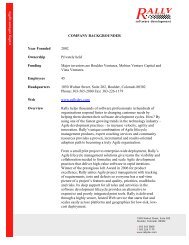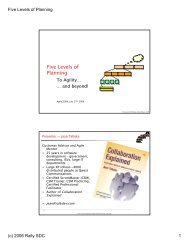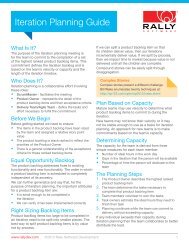The Agile Impact Report - Rally Software
The Agile Impact Report - Rally Software
The Agile Impact Report - Rally Software
You also want an ePaper? Increase the reach of your titles
YUMPU automatically turns print PDFs into web optimized ePapers that Google loves.
<strong>Agile</strong>’s <strong>Impact</strong> on Quality<br />
Defect counts mostly steady despite cutting schedules by more than 50%<br />
QSMA’s prior research shows that bug counts rise geometrically as schedules are compressed. Typically, “haste<br />
makes waste”; when large teams cut delivery schedules to four or five months as these teams did, defects will<br />
conservatively exceed industry averages by about four times. Instead, these companies experienced total<br />
defect counts that were significantly better than would be expected under these conditions. In fact, despite<br />
cutting schedules by more than 50 percent, results show the defect counts for the measured projects<br />
remained mostly steady. Two <strong>Rally</strong> customers maintained average defect counts and two customers were on<br />
the upper end of industry averages when compared to similar sized projects taking more than twice as long to<br />
deliver.<br />
Defects<br />
10,000<br />
<strong>Rally</strong> Projects<br />
<strong>Agile</strong> Companies<br />
1 Sigma line<br />
CNET<br />
QSMA SLIM database<br />
1 Sigma line<br />
Moody’s<br />
HomeAway<br />
BMC<br />
1,000<br />
100<br />
10<br />
Defects<br />
Fig. 3<br />
Despite Dramatic Schedule Compression,<br />
<strong>Agile</strong> Projects Maintained Normal Defect<br />
Counts<br />
1 10 100 1,000<br />
User Stories, Code (KSLOC)<br />
1<br />
It is important to note that the study did not measure when defects were captured and fixed during the release<br />
cycle. Neither did the study track how many defects were open at any one time. It is common for <strong>Agile</strong><br />
projects to have a large impact on these two metrics over test-last development processes.<br />
<strong>Agile</strong> projects use short time boxes to produce potentially shippable code. A two-week iteration will<br />
implement new stories, but it will also fix high priority bugs, re-factor existing code and add new tests to the<br />
regression suites that validate the stories are ready for acceptance. Along with <strong>Agile</strong> engineering practices such<br />
as continuous integration and test-driven development, these behaviors promote a “fail fast” philosophy<br />
where expensive defects are typically discovered and fixed earlier and more evenly throughout the release<br />
cycle. While not always lowering the total number of defects found in a given amount of code, these<br />
techniques enable teams to respond to flaws before they can negatively impact release dates and the customer<br />
experience. Another benefit is that <strong>Agile</strong> teams can have significantly lower open defect counts and their<br />
associated management overhead.<br />
<strong>The</strong> one downside of <strong>Agile</strong> projects being far less “defect-driven” is that classic defect metrics used to manage<br />
the release end game can become irrelevant. For example, when there are few open defects, charting defect<br />
find and fix rates in hopes of forecasting a ship date no longer provides useful information. Instead, these<br />
reports are replaced by questions into which failing tests or bugs stand in the way of accepting specific stories<br />
as “done.” This change can take some adjustment and may require new ways of reporting release readiness.<br />
6
















